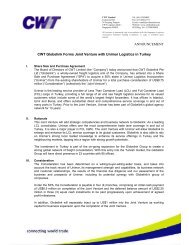notes to the financial statements - Investor Relations
notes to the financial statements - Investor Relations
notes to the financial statements - Investor Relations
You also want an ePaper? Increase the reach of your titles
YUMPU automatically turns print PDFs into web optimized ePapers that Google loves.
CWT Limited<br />
68<br />
NOTES TO THE FINANCIAL STATEMENTS<br />
YEAR ENDED 31 DECEMBER 2011<br />
3 SIGNIFICANT ACCOUNTING POLICIES (CONT’D)<br />
3.9 Financial instruments (cont’d)<br />
Cash flow hedge (cont’d)<br />
When <strong>the</strong> hedged item is a non-<strong>financial</strong> asset, <strong>the</strong> amount accumulated in equity is included in <strong>the</strong> carrying amount of <strong>the</strong><br />
asset when <strong>the</strong> asset is recognised. In o<strong>the</strong>r cases, <strong>the</strong> amount accumulated in equity is reclassified <strong>to</strong> profit or loss in <strong>the</strong><br />
same period that <strong>the</strong> hedged item affects profit or loss. If <strong>the</strong> hedging instrument no longer meets <strong>the</strong> criteria for hedge<br />
accounting, expires or is sold, terminated or exercised, or <strong>the</strong> designation is revoked, <strong>the</strong>n hedge accounting is discontinued<br />
prospectively. If <strong>the</strong> forecast transaction is no longer expected <strong>to</strong> occur, <strong>the</strong>n <strong>the</strong> balance in equity is reclassified <strong>to</strong> profit or<br />
loss.<br />
Non-derivative <strong>financial</strong> instruments<br />
Non-derivative <strong>financial</strong> instruments comprise investments in equity securities, non-current receivables, trade and o<strong>the</strong>r<br />
receivables, cash and cash equivalents, <strong>financial</strong> liabilities, and trade and o<strong>the</strong>r payables.<br />
Non-derivative <strong>financial</strong> instruments are recognised initially at fair value plus, for instruments not at fair value through profit or<br />
loss, any directly attributable transaction costs. Subsequent <strong>to</strong> <strong>the</strong> initial recognition, non-derivative <strong>financial</strong> instruments are<br />
measured as described below.<br />
A <strong>financial</strong> instrument is recognised if <strong>the</strong> Group becomes a party <strong>to</strong> <strong>the</strong> contractual provisions of <strong>the</strong> instrument. Financial<br />
assets are derecognised if <strong>the</strong> Group’s contractual rights <strong>to</strong> <strong>the</strong> cash flows from <strong>the</strong> <strong>financial</strong> assets expire or if <strong>the</strong> Group<br />
transfers <strong>the</strong> <strong>financial</strong> asset <strong>to</strong> ano<strong>the</strong>r party without retaining control or transfers substantially all <strong>the</strong> risks and rewards of<br />
<strong>the</strong> asset. Regular way purchases and sales of <strong>financial</strong> assets are accounted for at trade date, i.e. <strong>the</strong> date that <strong>the</strong> Group<br />
commits itself <strong>to</strong> purchase or sell <strong>the</strong> asset. Financial liabilities are derecognised if <strong>the</strong> Group’s obligations specified in <strong>the</strong><br />
contract expire or are discharged or cancelled.<br />
Available-for-sale <strong>financial</strong> assets<br />
The Group’s investment in equity securities is classified as available-for-sale <strong>financial</strong> assets. Subsequent <strong>to</strong> initial recognition,<br />
<strong>the</strong>y are measured at fair value plus any directly attributable transaction costs, and changes <strong>the</strong>rein, o<strong>the</strong>r than impairment<br />
losses, are recognised in <strong>the</strong> o<strong>the</strong>r comprehensive income and presented in fair value reserve in equity. When an investment<br />
is derecognised, <strong>the</strong> cumulative gain or loss previously recognised in equity is transferred <strong>to</strong> profit or loss.<br />
Loan and receivables<br />
Loans and receivables are <strong>financial</strong> assets with fixed or determinable payments that are not quoted in an active market.<br />
Loans and receivables are recognised initially at fair value plus any directly attributable transaction costs. Subsequent <strong>to</strong> initial<br />
recognition, loans and receivables are measured at amortised cost using <strong>the</strong> effective interest method, less any impairment<br />
losses.<br />
Cash and cash equivalents<br />
Cash and cash equivalents comprise cash balances and fixed deposits. For <strong>the</strong> purpose of <strong>the</strong> statement of cash flows, cash<br />
and cash equivalents are presented net of bank overdrafts which are repayable on demand and which form an integral part<br />
of <strong>the</strong> Group’s cash management.<br />
O<strong>the</strong>rs<br />
O<strong>the</strong>r non-derivative <strong>financial</strong> liabilities are measured at amortised cost using <strong>the</strong> effective interest method, less any impairment<br />
losses.<br />
O<strong>the</strong>r non-derivative <strong>financial</strong> liabilities comprise loans and borrowings, bank overdrafts, and trade and o<strong>the</strong>r payables.<br />
Bank overdrafts that are repayable on demand and form an integral part of <strong>the</strong> Group’s cash management are included as a<br />
component of cash and cash equivalents for <strong>the</strong> purpose of <strong>the</strong> statement of cash flows.





